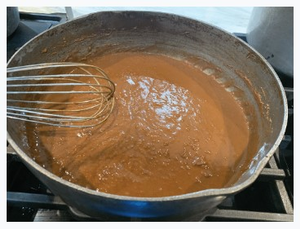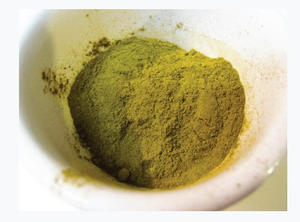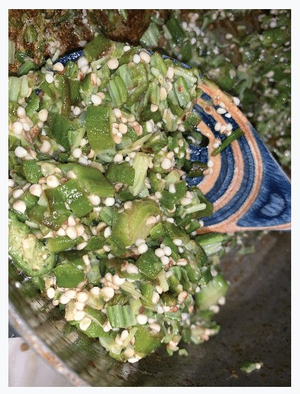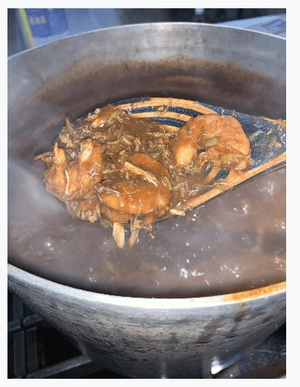Gumbo is one of the most
controversial topics of culinary discussion. Right down to the very meaning of
the word, opposing ideologies maintain what is (or what should be) considered
the right way to make gumbo. The dish, rooted in Louisiana
culture, is reflective of America
itself. What may seem like a straightforward recipe becomes a full-on
representation of this country’s identity—a delicious melting pot of cultures
stewed into one great dish.
Some believe gumbo to be
named after the West African word for okra, ki ngombo, which
supports the school of thought that gumbo is only to be made with okra. Others
believe it to be named after the Choctaw word kombo which means
“sassafras leaf,” known to most southerners as gumbo filé (pronounced fee-lay). This creates a
foundation for those who believe gumbo should only be made with gumbo filé.
What we do know is that these ingredients
were brought to the kitchen, recipes were shared, and gumbo made its debut in
American culture as early as the 17th century. It was a staple dish
prepared in Louisiana
that crossed class and cultural barriers.
 ROUX
ROUX
The base of this dish is the French
preparation called roux (pronounced roo), also known as the one thing on
which all gumbo connoisseurs will agree. This is a simple yet complex base that
gives the dish its most prominent flavor.
Simple because it is only two ingredients - flour
and fat. Complex both in flavor and its delicate nature which demands the
cook’s full attention while preparing it - mere seconds can make or break it.
Even the most seasoned chef can burn a roux.
To begin a roux, heat up the choice fat (cooking
oil, olive oil, butter, lard) on a medium heat until it glistens. Sift in
all-purpose flour and begin to whisk evenly into the fat. As you stir, the
color will develop from white to cream, from tan to peanut butter, and then you
get to the gumbo range- oak to cocoa. One thing to remember- don’t compromise
the dish with a burned roux, discard and start over.
The roux acts as a thickener, although it is
not the primary thickener in gumbo. Typically, a darker roux will give more
complex flavor to the dish, but the more the flour is broken down, the less
productive it is as a thickener.
 OKRA VS. GUMBO FILÉ
OKRA VS. GUMBO FILÉ
Some of the more divisive opinions behind
gumbo preparation depend upon the style of Louisiana cuisine on which it is based.
Okra, with its West African origins, came to America
most likely during the slave trade and became quickly rooted in the New Orleans cuisine. It
was used as a thickener in dishes and in other as a main ingredient. Often,
okra-based gumbos will have tomato added, as these two items were often paired
together.
When using okra in gumbo, it is equally as
important to cook it down as it is to cook down the roux. Okra is a
mucilaginous plant, which means it creates a liquid binder when cooked.
However, when cooked long enough, the sticky nature of the fluid in okra can be
cooked off and turned into a paste.
This is what they mean when they say
okra-based. Not that you will ‘see’ okra in the gumbo, but that it is an
integral part in making the base of the dish.
 The solitary use of gumbo filé was more commonly seen in Cajun dishes,
which was heavily influenced by Native American cuisine. Gumbo filé adds an earthiness to the dish and acts
as a thickener similar to okra but not as powerful.
The solitary use of gumbo filé was more commonly seen in Cajun dishes,
which was heavily influenced by Native American cuisine. Gumbo filé adds an earthiness to the dish and acts
as a thickener similar to okra but not as powerful.
Gumbo that uses only filé and no okra will have a thinner base
liquid. This is more common in meat gumbos, like chicken and sausage, or duck
and sausage.
Historically, gumbo filé was used as a substitute binder when okra
was not in season, because it was easier to dry, grind, and store gumbo file
than okra pods. Both items can be found at the grocery store these days,
although industry standards have allowed gumbo filé to be “cut” with sage as it can become
pricey per pound. (100% pure gumbo filé retails anywhere from $15-20/lb. Ground
sage is anywhere from $6-9/lb.) Be sure to read the label when purchasing gumbo
filé, or
ask your local spice merchant if their filé is pure.
CAJUN VS. CREOLE
This is where you begin to see the players
take sides. Louisiana has some of the greatest
food, however gumbo from Lafayette is
tremendously different than New
Orleans. This is because there are two main styles of
cooking gumbo - Cajun vs. Creole.
Typically, a Cajun gumbo is one thickened
with a dark roux and filé. This is a thinner style of gumbo and more prominent in the Galveston food scene.
Whereas a Creole gumbo is made with a dark roux but is thickened with Okra and
has the presence of tomato.
Creole gumbo is typically be found in New Orleans while Cajun
Gumbo is more likely to appear West of Bayou Lafourche. New Orleans famous Chef
Paul Prudhomme intertwined Cajun and Creole philosophies, which is why you are
more likely to see both gumbo filé and okra both used in gumbo today.
 PROTEINS AND GUMBO Z’HERBES
PROTEINS AND GUMBO Z’HERBES
The beauty of gumbo is not the roux, or even
the presence of okra and how much it is cooked down, but the freedom of using
any protein (or none) in the dish. Gumbo Z’Herbes is a vegan, plant-based gumbo
comprised literally of a melting pot of greens cooked down over an extended
period of time and served over rice.
This version of gumbo was made popular by the
Catholic Religion and consumed during Lenten on Holy Friday, a day when
followers of the faith abstain from meat products.
THE PROCESS
The secret to making a great Creole-style
seafood gumbo truly relies on the process in which items are added to the pot.
In any recipe, it is important to gather and prep all ingredients ahead of
time. This will ensure that everything is on hand and ready to be added. Save
the ends of the vegetables and shrimp shells to create the stock.
Begin with cooking down the okra, which can
take as long as, if not longer, than your roux. Stir frequently to ensure the
okra does not stick to the bottom of the pot, and periodically add water to
help break down the okra. When it’s done, it will look like a paste. Set aside.
Begin making the roux by whisking the flour
and fat constantly over medium heat. As soon as the color and sweet smell of
perfect gumbo roux is right, mix in the onion, celery, and bell pepper. This
process opens up your aromatics while simultaneously cooling down your roux and
stopping it from continuing to get darker.
Add Tomato sauce and okra paste and mix well.
Combine with equal parts stock and water by slowly adding water to the roux and
paste mixture, making sure the mixture is thoroughly incorporated. Add
seasoning, gumbo filé and bay leaves and bring to a boil, stirring periodically. Let
cook on a rolling boil for a minimum of four hours.
Add in protein at any point. Some prefer the
protein to be cooked down completely, while others like to see it. This is
optional, although there is a certain sweetness that shrimp and crab will add
to the dish when cooked down with the gumbo.
One secret that everyone should know: Let
gumbo sit a day before consuming. The chemical reaction that happens when gumbo
cools down and is heated back up does something magical to the dish that makes
it infinitely better than the day before. It is best served a day later with a
scoop of rice, corn mash/cornbread, or potato salad.
Next time you grab a bowl of gumbo at your
favorite spot on the island, think about what goes into making it and savor
every bite. It is a culinary masterpiece that is truly All American.
We would love to see what you create! Show us
your creations by tagging us on Facebook, Instagram or Twitter using hashtag:
#galvestonmonthly #cookinlikeconcetta
Concetta Maceo-Sims is a 3rd
generation Galvestonian with a colorful family history in the food and
entertainment industry. She works aside her father at Maceo Spice & Import
Company at 2706 Market Street
where she develops new recipes, caters, and maintains the shop. She credits her
elders for developing her palate and love for cooking, as she grew up observing
them in their element. Luckily, she picked up their kitchen secrets and is
willing to share them!